|  | | | | 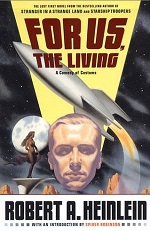

| | For Us, the Living
by Robert A. Heinlein
First written: 1938 (posthumously published in 2003)

 I’m sad that I’ve now read all the extant Heinlein fiction, this posthumous (and first) novel being the last piece for me. It certainly held 3.5 stars worth of enjoyment for a Heinlein fan, but much of that was in seeing the nascent ideas of the writer that I would devour in my childhood. In the story, a military pilot from 1939 dies, and his consciousness is thrown forward to 2086 where social and economic aspects of society are hugely altered, though technological advances are more conservative (but, dammit, I want my flying car). I’m sad that I’ve now read all the extant Heinlein fiction, this posthumous (and first) novel being the last piece for me. It certainly held 3.5 stars worth of enjoyment for a Heinlein fan, but much of that was in seeing the nascent ideas of the writer that I would devour in my childhood. In the story, a military pilot from 1939 dies, and his consciousness is thrown forward to 2086 where social and economic aspects of society are hugely altered, though technological advances are more conservative (but, dammit, I want my flying car). “Let me get out of these furs.” She walked away while fumbling with a zipper at her throat. The furs were all one garment which slipped off her shoulders and fell to the floor. Perry felt a shock like an icy shower and then a warm tingle. “Let me get out of these furs.” She walked away while fumbling with a zipper at her throat. The furs were all one garment which slipped off her shoulders and fell to the floor. Perry felt a shock like an icy shower and then a warm tingle. 
Robert A. Heinlein, Master Traveller Had Heinlein written nothing other than “—All You Zombies—”, he would still be a masterful Master Traveller.

| |
| | | | |

 
 | | | | 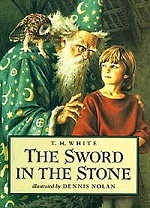

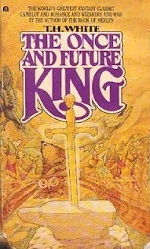

| | The Once and Future King
by T.H. White
First book: 1938

 Merlyn, who experiences time backward, is the traveler in this series, which was introduced to me by Denbigh Starkey, my undergraduate advisor at WSU and later a member of my Ph.D. committee. Merlyn, who experiences time backward, is the traveler in this series, which was introduced to me by Denbigh Starkey, my undergraduate advisor at WSU and later a member of my Ph.D. committee.

The first four of these short books in the series were collected (with a substantial cut and revision to #2) into a single volume, The Once and Future King, in 1958. A final part, The Book of Merlyn written in 1941, was published posthumously in 1971. - The Sword in the Stone, 1938
 —Arthur is crowned —Arthur is crowned - The Witch in the Wood, 1939
 aka The Queen of Air and Darkness (cut and revised), 1958 aka The Queen of Air and Darkness (cut and revised), 1958
 —young King Arthur —young King Arthur - The Ill-Made Knight (1940)
 —Sir Lancelot —Sir Lancelot - The Candle in the Wind (1958)
 —the end of Camelot —the end of Camelot - The Book of Merlyn (1977)
 —the final battle with Mordred —the final battle with Mordred EVERYTHING NOT FORBIDDEN IS COMPULSORY. EVERYTHING NOT FORBIDDEN IS COMPULSORY. 

—a sign at the ant colony
(and also physicist Murray Gell-Mann’s description of particle physics)
| |
| | | | |

 
 
 | | | | 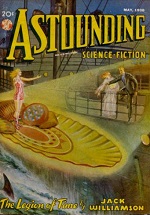

| | The Legion of Time
by Jack Williamson
First publication: Astounding Science Fiction, May–Jul 1938

After two beautiful women of two different possible futures appear to physicist Denny Lanning, he finds himself swept up by a time-traveling ship, the Chronion, along with a band of fighting men who swear their allegiance to The Legion of Time and its mission to ensure that the eviler of the two beautiful women never comes to pass. But Max Planck with the quantum theory, de Broglie and Schroedinger with the wave mechanics, Heisenberg with matrix mechanics, enourmously complicated the structure of the universe—and with it the problem of Time. But Max Planck with the quantum theory, de Broglie and Schroedinger with the wave mechanics, Heisenberg with matrix mechanics, enourmously complicated the structure of the universe—and with it the problem of Time.
 With the substitution of waves of probability for concrete particles, the world lines of objects are no longer the fixed and simple paths they once were. Geodesics have an infinite proliferation of possible branches, at the whim of sub-atomic indeterminism. With the substitution of waves of probability for concrete particles, the world lines of objects are no longer the fixed and simple paths they once were. Geodesics have an infinite proliferation of possible branches, at the whim of sub-atomic indeterminism.
 Still, of course, in large masses the statistical results of the new physics are not much different from those given by the classical laws. But there is a fundamental difference. The apparent reality of the universe is the same—but it rests upon a quicksand of possible change. Still, of course, in large masses the statistical results of the new physics are not much different from those given by the classical laws. But there is a fundamental difference. The apparent reality of the universe is the same—but it rests upon a quicksand of possible change. 
| |
| | | | |

 | | | | 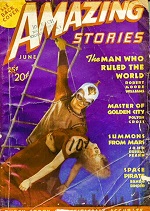 | | “The Invisible Bomber”
by Ralph Milne Farley (as by Lt. John Pease)
First publication: Amazing, Jun 1938

Here’s a new rule about what constitutes a time-travel story: If the author claims that there’s time travel in the story, then it’s a time-travel story. That’s the case for this story, which doesn’t feel like time travel to me, but in the afterward of The Omnibus of Time Farley says that the airplane bomber in this story becomes soundless and invisible via a “laminated” model of space-time in which a series of different worlds are stacked one on top of another, each just a short time in front of its predecessor. According to Farley, “time-traveling will carry the traveler, not into the future, but rather into an entirely different space-time continuum than our own.” The plane becomes invisible by traveling just a short distance toward the next world without reaching anywhere near it.

My thought on this is that the notion of time as a dimension does not have anything to do with the stacking dimension. In fact, I don’t think they can be the same dimension because that would imply that there is nothing to distinguish a point in our space-time continuum from a point with the same space-time coordinates in some other continuum.

P.S. I also didn’t care for the president’s solution to the story’s problem. We human beings live in a three dimensional space, or which time has sometimes been called the fourth dimension. But did it ever occur to you, Mr. President, that we do not extend in time. We never experience any other time than the present. Our so-called space-time existence is thus seen to be a mere three-dimensional layer, or lamina, infinitely thin in the time direction. There could exist another three-dimensional space just a second or two away from ours, and we would never know it. We human beings live in a three dimensional space, or which time has sometimes been called the fourth dimension. But did it ever occur to you, Mr. President, that we do not extend in time. We never experience any other time than the present. Our so-called space-time existence is thus seen to be a mere three-dimensional layer, or lamina, infinitely thin in the time direction. There could exist another three-dimensional space just a second or two away from ours, and we would never know it. 
| |
| | | | |

 | | | | 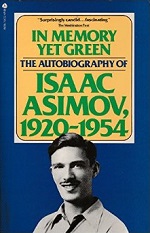 Part I of Asimov’s autobiography Part I of Asimov’s autobiography

| | “Cosmic Corkscrew”
by Isaac Asimov
First publication: written in 1938, but unpublished

“Cosmic Corkscrew” was the first story that Asimov ever wrote for submission to the pulp magazines of the day. In the first part of his autobiography, he describes starting the story, setting it aside, and returning to it some thirteen months later. It was the story that he took with him on his first visit to John Campbell, inquiring about why the July 1938 Astounding was late arriving. Alas, the story was rejected and then lost, but it did have time travel! In it, I viewed time as a helix (this is, as something like a bedspring). Someone could cut across from one turn directly to the next, thus moving into the future by some exact interval, but being incapable of traveling one day less into the future. (I didn’t know the term at the time, but what I had done was to “quantize” time travel.) In it, I viewed time as a helix (this is, as something like a bedspring). Someone could cut across from one turn directly to the next, thus moving into the future by some exact interval, but being incapable of traveling one day less into the future. (I didn’t know the term at the time, but what I had done was to “quantize” time travel.) 

—In Memory Yet Green, Part I of Asimov’s autobiography
Isaac Asimov, Master Traveller Even though Asimov’s first story was lost, I find it comforting that the story was about time travel, a theme that he returned to over-and-over again with far more variety than any of his other themes. My favorite Asimov story, given to me by my Grandpa Main in its original 1958 issue of Galaxy will always be “The Ugly Little Boy.”

| |
| | | | |

 | | | | 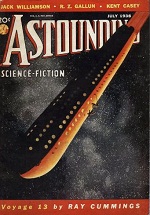

| | Language for Time Travelers
by L. Sprague de Camp
First publication: Astounding Science Fiction, Jul 1938

 This essay convinced me to add at least a few nonfiction works to my list. After all, why not? De Camp interleaves a few fictional vignettes with thoughts on how language might change over the next few centuries. For me, it shows how well the time travel paradigm had been established by 1939. This essay convinced me to add at least a few nonfiction works to my list. After all, why not? De Camp interleaves a few fictional vignettes with thoughts on how language might change over the next few centuries. For me, it shows how well the time travel paradigm had been established by 1939.

As a bonus, this essay appeared in the very issue of Astounding that has the final installment of The Legion of Time and which caused all the trouble in my story “Saving Astounding.” Wah lenksh? Inksh lenksh, coss. Wah you speak? Said, sah-y, daw geh-ih. Daw, neitha. You fresh? Jumm? Wah lenksh? Inksh lenksh, coss. Wah you speak? Said, sah-y, daw geh-ih. Daw, neitha. You fresh? Jumm? 
L. Sprague de Camp, Master Traveller Even before de Camp produced the award winning Lest Darkness Fall, my Grandpa Main had identified him as a Master Traveller based on “Language for Time Travelers,” which was the first of many de Camp essays. Appropriately enough, de Camp’s enjoyable autobiography is titled Time and Chance.

| |
| | | | |

 | | | | 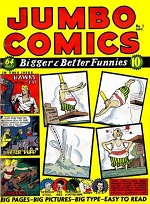

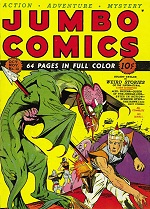

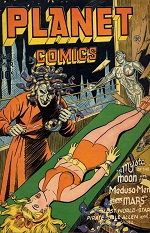

| | Fiction House Comics
published by Thurman T. Scott
First time travel: Jumbo Comics 1, Sep 1938

Fiction House was a major publisher of pulp magazines and comics through the 1950s. Their comics came out of a pulp tradition with stories of jungle heros (Sheena, Queen of the Jungle), air aces (Wings Comics), westerns (Cowgirl Romances), science fiction (Planet Comics), and, of course, Jumbo Comics (Action! Adventure! Mystery!).
The first time travel that I tracked down here was an adventurer named Stuart Taylor who teamed with Dr. Hayward and his beautiful daughter Lora (later Laura) in many issues of Jumbo Comics. For me, it was exciting for two reasons: (1) It’s some of the earliest time travel in a comic book that I know of; (2) At least the first few stories were drawn by Jack King Kirby (as by Curt Davis). Time travel probably occurred in 1-4 (“The Experiment of Kromo’), as well as in 5-14, 17-78, 84-139, plus a reprint in 140. (Numbers 15-16 had no time travel; I think 79-83 are shorter, with no Stuart Taylor, and Stu disappeared after 140.)
Their science fiction comic, Planet Comics, had at least one bout of time travel when a chronoscope brought dinosaurs and such to The Lost World of heros Hunt and Lyssa (Planet Comics 41, March 1946); it also short, 2-page stories, at least one of which was time travel (“Lost World of Time” in Planet Comics 7, July 1940). My name is Stuart Taylor. Do you mind if I ask what seems a silly question! What year is this? My name is Stuart Taylor. Do you mind if I ask what seems a silly question! What year is this? 

—from Jumbo Comics 13
| |
| | | | |

 
No Time Travel. Move along. |
“Island of the Individualists” by Nat Schachner, Astounding, May 1938 [long sleep ]

“The Dangerous Dimension” by L. Ron Hubbard, Astounding, Jul 1938 [just teleportation ]

“Through the Time-Radio” by Stanton A. Coblentz, Marvel Science Stories, Aug 1938 [viewing the past ]

“Time for Sale” by Ralph Milne Farley, Amazing, Aug 1938 [differing time rates ]

| |     |